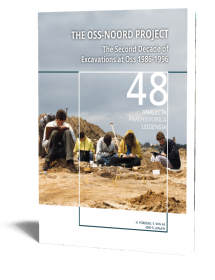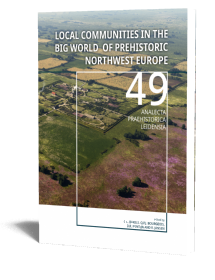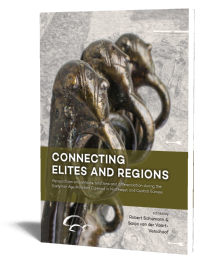Rural Settlement
Relating buildings, landscape, and people in the European Iron Age
Edited by Dave C. Cowley, Manuel Fernández-Götz, Tanja Romankiewicz & Holger Wendling | 2019

Rural Settlement
Relating buildings, landscape, and people in the European Iron Age
Edited by Dave C. Cowley, Manuel Fernández-Götz, Tanja Romankiewicz & Holger Wendling | 2019
Paperback ISBN: 9789088908187 | Hardback ISBN: 9789088908194 | Imprint: Sidestone Press | Format: 210x280mm | 286 pp. | Language: English | 40 illus. (bw) | 78 illus. (fc) | Keywords: Iron Age Europe; rural settlement; settlement systems; landscape territories; Iron Age buildings; settlement hierarchies; GIS; digital topographic survey; ethnoarchaeology | download cover
Read online or downloaded 5144 times
-
Digital & Online access
This is a full Open Access publication, click below to buy in print, browse, or download for free.
-
Buy via Sidestone (EU & UK)
-
Buy via our Distributors (WORLD)
For non-EU or UK destinations you can buy our books via our international distributors. Although prices may vary this will ensure speedy delivery and reduction in shipping costs or import tax. But you can also order with us directly via the module above.
UK international distributor
USA international distributor
-
Bookinfo
Paperback ISBN: 9789088908187 | Hardback ISBN: 9789088908194 | Imprint: Sidestone Press | Format: 210x280mm | 286 pp. | Language: English | 40 illus. (bw) | 78 illus. (fc) | Keywords: Iron Age Europe; rural settlement; settlement systems; landscape territories; Iron Age buildings; settlement hierarchies; GIS; digital topographic survey; ethnoarchaeology | download cover
Read online or downloaded 5144 times

We will plant a tree for each order containing a paperback or hardback book via OneTreePlanted.org.
The majority of humanity have lived out their lives in a ‘rural’ context, and even in our increasingly urbanised world almost half of the global population still live in rural areas. In the European Iron Age, the vast mass of the population clearly lived in small hamlets and farmsteads, and this overarching ‘rurality’ is important for understanding these societies. While there has been a pronounced focus in recent archaeological research on patterns of centralisation and urbanisation, there is a need to reincorporate ‘rural life’ or rurality into these discussions of how people lived.
This book is a contribution to the study of rural life in Iron Age Europe, collating case studies extending from southern Spain to northern Scotland and from Denmark to the Balkans. Papers are grouped thematically to open up cross-regional comparisons, ranging across studies of buildings, farms – the basic unit of Iron Age life consisting of its inhabitants, its livestock and associated agricultural lands – to wider settlement patterns and land use strategies. The 29 papers in this volume discuss the disposition, form and organisation of rural settlements, as well as underlying social and economic networks, illustrating both the variability between regions, and also common themes in cultural, economic and social interactions.
This volume provides an up-to-date overview of current research, presenting new results for the Iron Age specialist as well as a wider audience interested in the rich tapestry of rural settlement in Europe.
This publication was made possible by a grant from:
Exploring rural settlement in Iron Age Europe – An introduction
Dave Cowley, Manuel Fernández-Götz, Tanja Romankiewicz & Holger Wendling
Beyond the site: settlement systems and territories
Regional settlement entities or terroirs in Late Iron Age northern France
Alexandra Cony
Regional aspects of landscape exploitation and settlement structure in Denmark in the Late Bronze Age and Early Iron Age
Mads Runge
Iron Age settlement in mid-west Ireland
Katharina Becker
Recent research on the Arras Culture in its landscape setting
Peter Halkon
Settlement and landscape in the Iron Age of eastern Iberia
Ignasi Grau Mira
Approaching Late Iron Age rural landscapes: New ways of looking at the archaeological record in the southeast Iberian Peninsula
Leticia López-Mondéjar
From hut to factory: models of rural occupation in the Lower Guadalquivir valley during the 1st millennium BC
Eduardo Ferrer-Albelda, Francisco José García-Fernández & José Luis Ramos-Soldado
Space and place in the Early Iron Age in eastern Burgundy
Régis Labeaune
Settlement units and buildings
The chronology of wetland settlement and its impact on Iron Age settlement dynamics in southwest Scotland
Graeme Cavers & Anne Crone
Settlement nucleation and farmstead stabilisation in the Netherlands
Karen M. de Vries
Turf worlds: Towards understanding an understudied building material in rural Iron Age architecture – some thoughts in a Scottish context
Tanja Romankiewicz
The concept of ‘house’ and ‘settlement’ in the Iron Age of the middle Tisza region
Péter F. Kovács
House or workshop? A case study of two pit-houses at the Iron Age settlement site of Michałowice, Kazimierza Wielka county (Poland)
Jan Bulas, Michał Kasiński & Gabriela Juźwińska
Late Iron Age settlement in Hungary
Károly Tankó & Lőrinc Timár
At the fringes of the La Tène world – The Late Iron Age rural occupation of the Banat region, Romania
Andrei Georgescu
Late Iron Age rural settlements in southern Pannonia
Ivan Drnić
Meillionydd: a Late Bronze and Iron Age double ringwork enclosure in northwest Wales
Katharina Möller & Raimund Karl
The changing patterns of La Tène Farmsteads in Central and Western continental Europe
Angelika Mecking
Rural settlement patterns in urbanised Areas: The oppidum of Manching
Thimo J. Brestel
Status and settlement hierarchy
Rural residential places? Rethinking the Fürstensitze-elites correlation
Manuel Fernández-Götz & Ian Ralston
Middle and Late La Tène rural aristocratic establishments in Gaul: plans and organisation
Stephan Fichtl
Scordiscan stronghold: A Late Iron Age multiple fortification at Bačka Palanka in northern Serbia
Holger Wendling
The emergence of oppida in Celtiberia: The case study of Los Rodiles (Guadalajara, Spain)
Marta Chordá, Álvaro Sánchez-Climent, Emilio Gamo & María Luisa Cerdeño
New tools and perspectives
Microtopographies of Dacian upland settlement strategies and community aggregation trends in the Orăştie Mountains, Romania
Ioana A. Oltean & João Fonte
A structured Iron Age landscape in the hinterland of Knežak, Slovenia
Boštjan Laharnar, Edisa Lozić & Benjamin Štular
Around the Münsterberg: How online tools help us to rethink our data
Loup Bernard
Archaeology, landscapes, and heritage in the southeast Iberian Peninsula: The ALHIS project
Leticia López-Mondéjar
Rural domestic patterns in northwest Iberia: An ethnoarchaeological approach to Iron Age household layout
Lucía Ruano & Luis Berrocal-Rangel
Dave C. Cowley BA
Dave Cowley is an archaeologist in the Survey & Recording Group at Historic Environment Scotland, where he manages a programme of archaeological mapping. His research is focused on survey methodology and the development of the landscape, with a specific interest in Iron Age settlement patterns. He is undertaking part-time doctoral research at Ghent University on population in southeast Scotland in the period 1000 BC to AD 1000.
Dr. Manuel Fernández-Götz
Manuel Fernández-Götz is Reader in European Archaeology and Head of the Archaeology Department at the University of Edinburgh. He has authored ca. 200 publications and held visiting scholar positions at the universities of Oxford, Cambridge, and Brown, among others. His main research interests are Iron Age societies in Central and Western Europe, the archaeology of identities, and conflict archaeology. He has directed fieldwork projects in Spain, Germany, the United Kingdom, and Croatia.
Dr.-Ing. Tanja Romankiewicz
Tanja Romankiewicz is a Research Fellow at the School of History, Classics and Archaeology at the University of Edinburgh. Her PhD investigated the complex roundhouses of the Scottish Iron Age and was published as a monograph with British Archaeological Reports in 2011. The dissertation was jointly undertaken at the TU of Berlin and the University of Edinburgh and funded by the Cusanuswerk e.V.
Dr. Holger Wendling
Holger Wendling is Head of the Department of Archaeology at the Salzburg Museum and the Dürrnberg Research Department at the Keltenmuseum Hallein. He studied at the University of Tübingen and at the Institute of Archaeology, University College London, developing a strong interest in the Iron Age of temperate Europe. His doctoral thesis dealt with the late La Tène site at Breisach, Münsterberg, and the settlement archaeology of the upper Rhine region. His current research focuses on settlement structures and burials at the Iron Age site of Dürrnberg in Austria, also integrating the Bronze and Iron Age evidence in the wider Salzburg area.
Abstract:
The majority of humanity have lived out their lives in a ‘rural’ context, and even in our increasingly urbanised world almost half of the global population still live in rural areas. In the European Iron Age, the vast mass of the population clearly lived in small hamlets and farmsteads, and this overarching ‘rurality’ is important for understanding these societies. While there has been a pronounced focus in recent archaeological research on patterns of centralisation and urbanisation, there is a need to reincorporate ‘rural life’ or rurality into these discussions of how people lived.
This book is a contribution to the study of rural life in Iron Age Europe, collating case studies extending from southern Spain to northern Scotland and from Denmark to the Balkans. Papers are grouped thematically to open up cross-regional comparisons, ranging across studies of buildings, farms – the basic unit of Iron Age life consisting of its inhabitants, its livestock and associated agricultural lands – to wider settlement patterns and land use strategies. The 29 papers in this volume discuss the disposition, form and organisation of rural settlements, as well as underlying social and economic networks, illustrating both the variability between regions, and also common themes in cultural, economic and social interactions.
This volume provides an up-to-date overview of current research, presenting new results for the Iron Age specialist as well as a wider audience interested in the rich tapestry of rural settlement in Europe.
This publication was made possible by a grant from:
Contents
Exploring rural settlement in Iron Age Europe – An introduction
Dave Cowley, Manuel Fernández-Götz, Tanja Romankiewicz & Holger Wendling
Beyond the site: settlement systems and territories
Regional settlement entities or terroirs in Late Iron Age northern France
Alexandra Cony
Regional aspects of landscape exploitation and settlement structure in Denmark in the Late Bronze Age and Early Iron Age
Mads Runge
Iron Age settlement in mid-west Ireland
Katharina Becker
Recent research on the Arras Culture in its landscape setting
Peter Halkon
Settlement and landscape in the Iron Age of eastern Iberia
Ignasi Grau Mira
Approaching Late Iron Age rural landscapes: New ways of looking at the archaeological record in the southeast Iberian Peninsula
Leticia López-Mondéjar
From hut to factory: models of rural occupation in the Lower Guadalquivir valley during the 1st millennium BC
Eduardo Ferrer-Albelda, Francisco José García-Fernández & José Luis Ramos-Soldado
Space and place in the Early Iron Age in eastern Burgundy
Régis Labeaune
Settlement units and buildings
The chronology of wetland settlement and its impact on Iron Age settlement dynamics in southwest Scotland
Graeme Cavers & Anne Crone
Settlement nucleation and farmstead stabilisation in the Netherlands
Karen M. de Vries
Turf worlds: Towards understanding an understudied building material in rural Iron Age architecture – some thoughts in a Scottish context
Tanja Romankiewicz
The concept of ‘house’ and ‘settlement’ in the Iron Age of the middle Tisza region
Péter F. Kovács
House or workshop? A case study of two pit-houses at the Iron Age settlement site of Michałowice, Kazimierza Wielka county (Poland)
Jan Bulas, Michał Kasiński & Gabriela Juźwińska
Late Iron Age settlement in Hungary
Károly Tankó & Lőrinc Timár
At the fringes of the La Tène world – The Late Iron Age rural occupation of the Banat region, Romania
Andrei Georgescu
Late Iron Age rural settlements in southern Pannonia
Ivan Drnić
Meillionydd: a Late Bronze and Iron Age double ringwork enclosure in northwest Wales
Katharina Möller & Raimund Karl
The changing patterns of La Tène Farmsteads in Central and Western continental Europe
Angelika Mecking
Rural settlement patterns in urbanised Areas: The oppidum of Manching
Thimo J. Brestel
Status and settlement hierarchy
Rural residential places? Rethinking the Fürstensitze-elites correlation
Manuel Fernández-Götz & Ian Ralston
Middle and Late La Tène rural aristocratic establishments in Gaul: plans and organisation
Stephan Fichtl
Scordiscan stronghold: A Late Iron Age multiple fortification at Bačka Palanka in northern Serbia
Holger Wendling
The emergence of oppida in Celtiberia: The case study of Los Rodiles (Guadalajara, Spain)
Marta Chordá, Álvaro Sánchez-Climent, Emilio Gamo & María Luisa Cerdeño
New tools and perspectives
Microtopographies of Dacian upland settlement strategies and community aggregation trends in the Orăştie Mountains, Romania
Ioana A. Oltean & João Fonte
A structured Iron Age landscape in the hinterland of Knežak, Slovenia
Boštjan Laharnar, Edisa Lozić & Benjamin Štular
Around the Münsterberg: How online tools help us to rethink our data
Loup Bernard
Archaeology, landscapes, and heritage in the southeast Iberian Peninsula: The ALHIS project
Leticia López-Mondéjar
Rural domestic patterns in northwest Iberia: An ethnoarchaeological approach to Iron Age household layout
Lucía Ruano & Luis Berrocal-Rangel
Dave C. Cowley BA
Dave Cowley is an archaeologist in the Survey & Recording Group at Historic Environment Scotland, where he manages a programme of archaeological mapping. His research is focused on survey methodology and the development of the landscape, with a specific interest in Iron Age settlement patterns. He is undertaking part-time doctoral research at Ghent University on population in southeast Scotland in the period 1000 BC to AD 1000.
Dr. Manuel Fernández-Götz
Manuel Fernández-Götz is Reader in European Archaeology and Head of the Archaeology Department at the University of Edinburgh. He has authored ca. 200 publications and held visiting scholar positions at the universities of Oxford, Cambridge, and Brown, among others. His main research interests are Iron Age societies in Central and Western Europe, the archaeology of identities, and conflict archaeology. He has directed fieldwork projects in Spain, Germany, the United Kingdom, and Croatia.
Dr.-Ing. Tanja Romankiewicz
Tanja Romankiewicz is a Research Fellow at the School of History, Classics and Archaeology at the University of Edinburgh. Her PhD investigated the complex roundhouses of the Scottish Iron Age and was published as a monograph with British Archaeological Reports in 2011. The dissertation was jointly undertaken at the TU of Berlin and the University of Edinburgh and funded by the Cusanuswerk e.V.
Dr. Holger Wendling
Holger Wendling is Head of the Department of Archaeology at the Salzburg Museum and the Dürrnberg Research Department at the Keltenmuseum Hallein. He studied at the University of Tübingen and at the Institute of Archaeology, University College London, developing a strong interest in the Iron Age of temperate Europe. His doctoral thesis dealt with the late La Tène site at Breisach, Münsterberg, and the settlement archaeology of the upper Rhine region. His current research focuses on settlement structures and burials at the Iron Age site of Dürrnberg in Austria, also integrating the Bronze and Iron Age evidence in the wider Salzburg area.
-
Digital & Online access
This is a full Open Access publication, click below to buy in print, browse, or download for free.
-
Buy via Sidestone (EU & UK)
-
Buy via our Distributors (WORLD)
For non-EU or UK destinations you can buy our books via our international distributors. Although prices may vary this will ensure speedy delivery and reduction in shipping costs or import tax. But you can also order with us directly via the module above.
UK international distributor
USA international distributor
- Browse all books by subject
-
Search all books

We will plant a tree for each order containing a paperback or hardback book via OneTreePlanted.org.
You might also like:
© 2025 Sidestone Press KvK nr. 28114891 Privacy policy Sidestone Newsletter Terms and Conditions (Dutch)









